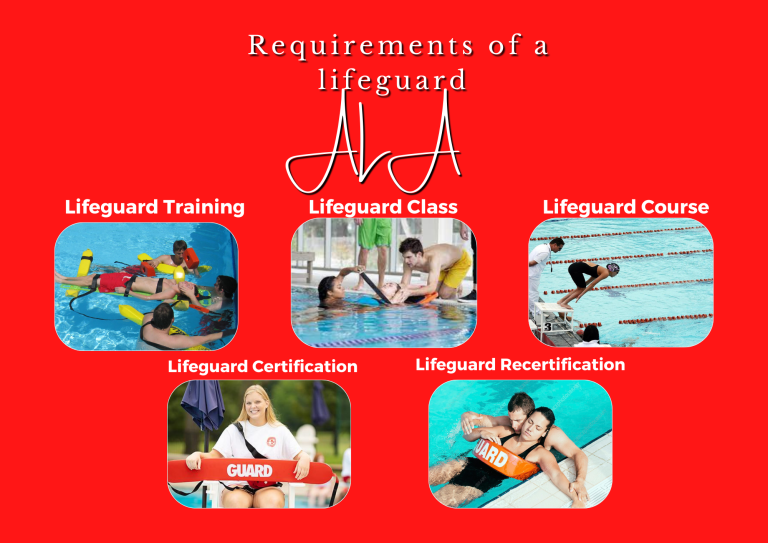Lifeguards at swimming pools, beaches, lakes, and other aquatic facilities must be trained to respond to injuries. Potential drowning, and other medical emergencies. They must also maintain order and enforce safety rules. And may also be responsible for assisting and instructing customers on these rules. Lifeguard training focuses on water rescue techniques. Most employers also require lifeguards to learn CPR and first aid. Which are part of lifeguard training courses approved by the United States Lifeguard Standards Commission.
Physical requirements
Anyone who turns 15 by completing a lifeguard training course could qualify for training if they demonstrate. They can swim 50 yards (45.72 m) without stopping to be a lifeguard in shallow water or 300 yards (274.32 m) without stopping to be a lifeguard in deeper water. Very deep water training candidates must also swim 10 yards (9.14 m) with a 20-pound (9.07 kg) weight attached to their bodies. While shallow water lifeguard candidates may walk the distance while holding the same weight. The full 300 yard (274.32 m) swim event includes both breaststroke and front crawl and shallow diving. Lifeguard courses in coastal areas require non-stop swimming 550 yards (502.92 m), plus shallow water diving.
Water rescue training
Aquatic rescue training consists of instruction in methods for entering the water and rescuing a swimmer in trouble. These methods prevent damage to lifeguards as well as protect the person being rescued from further harm. Some of the methods lifeguards learn during their training are side entry. Which is used to enter the water when a victim is in shallow or populated water near shore. Front or rear rescue for victims who are they are drowning and the use of boards to pull out an injured swimmer.
Injury stabilization
Basic lifeguard training includes instruction in caring for neck and back injuries. These injuries must be supported before a victim can move. And techniques taught in an approved lifeguard training course include the use of a kickboard and head and chin supports for victims lying on their backs. and upside down. Deep water spinal stabilization techniques are included in deep water or waterfront lifeguard training courses.
First Aid and CPR
The first aid and CPR training that accompanies a lifeguard course consists of training lifeguards in one and two person CPR for adults and children. As well as learning how to use a cardiac defibrillator. Use of a breathing valve, application of splints and slings. And control of bleeding are also included in lifeguard first aid training. Once a lifeguard has completed a full course. She must demonstrate mastery of all the skills she has learned and then take written lifeguard tests before being certified as a lifeguard by the American Lifeguard Association.
Lifeguard Training Guide
How should a lifeguard train?
In this article we will analyze what are the parameters that should be part of the training of a professional lifeguard. Especially those related to the development of physical condition and the more specific technical aspects their profession.
The lifeguard training
First responders play an important role in public safety. Their physical condition has a major direct impact on their ability to perform rescues efficiently. Whether they are working in aquatic facilities or natural aquatic spaces.
An adequate physical training plan adapted to the needs of your profession. And carrying out adequate eating strategies will be essential for maintaining a good physical condition.
Drowning Process
Before beginning to list the most relevant aspects of lifeguard training. It is important to detail how drowning by submersion occurs:
- At first, the person who is in the water suffers from respiratory failure since they cannot keep their head above the water.
- From there, a panic response ensues (Shaker, 2004).
- At this time the person stops breathing and fights energetically to stay afloat.
- This does not last more than a few seconds where a forced inspiration is made in which the water enters the larynx and pharynx.
- This whole process does not last more than 2 minutes (Orlowski, 1987).
- Here begins cerebral hypoxia , since the ingestion of liquid (water in this case) causes loss of consciousness. Which will trigger respiratory arrest and finally cardiac arrest and death (Orlowski et al, 1989).
Physical condition of the lifeguard training
Due to all this, the lifeguard must contemplate in his training an integral development of all physical capacities (Palacios, 2008). In addition, the rescuer must adapt all aspects related to strength, speed and resistance to the demands of his profession.
Must Read: How to Improve Heart Health: Diet, Vitamins, Exercise, and More


